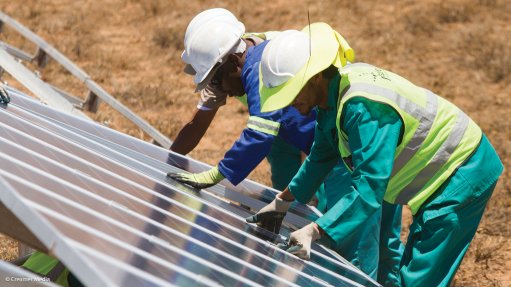SA 2016/17 BUDGET
This article has been supplied as a media statement and is not written by Creamer Media. It may be available only for a limited time on this website.
Company Announcement - Minister Gordhan presented his budget speech to Parliament earlier today. Summarised below are important aspects from a government grant and incentives perspective.
The Green Economy
Carbon tax
There is very little mention of carbon tax in this year’s budget. The Finance Minister makes no reference to it in his speech. However, the 2016 Budget Review states that the carbon tax will be ‘revenue neutral’ up to 2020 given the current economic outlook in South Africa. There is no clarity provided on what exactly is meant by ‘revenue neutral’ and what the post-2020 implications would be and whether this principle of ‘revenue neutrality’
will be retained.
The 2016 Budget does not mention a delay in the implementation of the carbon tax. As such, companies should still operate under the assumption that the carbon tax will be introduced in January 2017. However, it is not clear whether the introduction of the carbon tax in 2017 leaves sufficient time for National Treasury to do the work required. It is also important to note that National Treasury does not appear to have budgeted for this tax for the 2016/2017 financial year which may call into question the introduction date of January 2017.
Section 12L – energy efficiency incentive
No changes have been announced to the energy effiency section 12L incentive. It is important to note that South African Revenue Service has recent- ly issued guidance that is open for comment on the tax deduction available for energy efficiency savings under section 12L.
Given the recent amendments which increased the ad- ditional allowance from R0.45/kWh to R0.95/kWh, it Environmental taxes was to be expected that Treasury will allow the effect of this change to take place before any new changes are considered.
Any changes in the near future are expected to focus on improving access and take up of the incentive. Such measures are likely to include a simplified approach for measurement and verification of smaller projects (M&V approach for smaller projects).
Environmental Taxes
Below is a summary of the most significant changes to environmental taxes.
| Taxes | Explanation | % Increase |
| Tyre Levy | Implemented at a rate of R2.30/kg of tyre effective 1 October 2016. The levy will replace the current fee arrangements for tyres as regulated by the Department of Environmental Affairs. | 0% |
| Incandescent Globe Tax | Increased from R4.00 to R6.00 per globe effective 1 April 2016. | 50% |
| Plastic Bag Levy | Increased from 6 cents per bag to 8 cents per bag effective 1 April 2016. | 33% |
Energy Generation Programmes and Incentives
Independent Power Producers
It is clear that government intends to invest in the energy sector and that the IPP programmes are here to stay. Accompanying the generally pro privatisation tone of the overall budget speech, there is renewed commitment to partner with the private sector to co-invest in energy infrastructure. This is supported by the fact that National Treasury has committed a total of R865.4 billion over the next three years towards supporting infrastructure. A portion of this will most likely be allocated to the energy sector and the development of IPPs. These are intended to encourage private investment and improve the ease of doing business. National Treasury has also added R 200 billion to contingent liabilities in 2015/16. This is to cover guarantees to IPPs in the event of a default in payment to the IPPs by Eskom. Interestingly, this is the first year that government have allowed for this as a contingent liability.
Renewable Energy Incentives
Government already provides incentives to encourage investment in renewable energy through targeted ac- celerated depreciation allowances. However, capital expenditure that indirectly supports renewable electricity production, such as the construction of fences and roads, does not qualify for such deductions. Government will consider enhancing existing provisions to include these necessary indirect infrastructure costs and should consider providing an additional tax allowance on these costs.
Clean Fuels
Government will provide an accelerated depreciation allowance for a limited time to allow for South African oil refineries to invest in the capital required to meet the new fuel specifications. This accelerated depreciation allowance will allow qualifying capital expenditure to be deducted over a three-year period, instead of the normal five years.
Government has a range of targeted incentives to support industrialisation. A total of R10.2 billion over the medium term has been allocated to manufacturing development incentives and R3.4 billion to the special economic zones programme, largely for bulk infrastructure.
The total manufacturing incentive budget has been increased by 18% over the 2015/16 period. It is interesting to note that an above inflationary increase has been made to manufacturing incentives of 14% (R500 million). The reason for this increase could be contributed to the new Black Industrialist incentive which was recently launched by the Department of Trade and Industry.
Investment facilitation
Government has been announced that the DTI will introduce a new Investment Promotion and Inter-Departmental Clearing House which will act as a one-stop shop to facilitate investment. Government agencies involved in any aspect of investment, such as regulations, permits, licensing, infrastructure, and incentives, are to be brought into a single cohesive structure that coordinates and streamlines processes to provide prompt, efficient and transparent ser- vices to investors. This move is welcomed as it recognises that there is a significant amount of red tape in South Africa and investors required streamlined processes.
Black Industrialist (BI) Incentive
The BI incentive is a recently launched incentive which is expected to create 100 black industrialists over a period of 3 years. The Minister confirmed governments commitment to this programme in his speech and indicated that the Industrial Development Corporation (IDC) has set aside R23 billion to fund this initiative. Although the Minister did not make any announcement on a grant budget for this programme, the DTI budget for incen- tives has gone up by 18% in the medium term and we expect that a part of this increase will go towards the BI incentive.
Section 12I – Additional tax allowance
The section 12I incentive was implemented in 2010 with a budget for allowances of R20 billion. The window period for the incentive was extended to 31 December 2017 but with no additional allowance to top up the R20 billion. As of today, 79 projects have been approved and an amount of R17 billion has been allocated in additional allowances. With the lowering of the entry requirements to R50 million a substantial increase in ap- plications have been submitted and approved by the Minister of Trade and Industry and it is estimated that the budget will be depleted in the second quarter of this financial year.
We strongly advise that government starts a process to investigate a replacement tax allowance programme or extend the current 12I tax allowance with additional budget before the end of 2016 to ensure that a favourable investment climate is maintained.
Manufacturing Competitiveness Enhancement Programme (MCEP)
MCEP has over the past few years received several mentions indicating the importance of the programme in terms of stimulating and sustaining growth of manufacturing concerns in South Africa. In October 2015, it was announced to the public that the application process had been suspended and any company that hadn’t received approval would be rejected from the process due to oversubscription. The budget speech confirms the budgetary constraints and that no provision has been included to increase the amounts available to local manufacturing concerns. It is vital that in the redesign of the programme, the DTI engages with manufacturing entities to ensure that they meet their policy objectives.
Section 11D – Research and Development incentive
The tax regime for the incentive changed to a pre-approval process on 1 October 2012 which resulted in a 68% decrease in allowances claimed. There was an improvement in the 2013/2014 year but the allowances claimed are still 34% less than 2011/2012 levels. Government aims to increase gross expenditure on research and development to 1.5 per cent of GDP by 2019 from the current level of 0.76 per cent. The incentive will need to be more generous in order to reach this target especially with regards to software development which has had historically low approval rates (< 25%).
The Minister of Science and Technology established a task team to focus on the challenges faced by busi- nesses in accessing the incentive. Its work should be completed in April 2016, after which proposals will be considered to enhance the incentive.
Support Programme for Industrial Innovation
The budget for the next three years amounts to R192.3 million (R60.8 million for 2016/1, R63.9 million for 2017/18 and R67.6 million for 2018/19). This budget is in line with the 2015 Budget Review and is a small budget relative to the allocations provided for other incentives. In order for Government to finance the pent up demand which developed over the past two years when the scheme was effectively suspended, the DTI may
have to reallocate money from other incentive programmes.
We suggest that Government centralizes the various R&D incentives in one Government department to ensure that the process is streamlined and effective.
Submitted by Cova Advisory
Comments
Press Office
Announcements
What's On
Subscribe to improve your user experience...
Option 1 (equivalent of R125 a month):
Receive a weekly copy of Creamer Media's Engineering News & Mining Weekly magazine
(print copy for those in South Africa and e-magazine for those outside of South Africa)
Receive daily email newsletters
Access to full search results
Access archive of magazine back copies
Access to Projects in Progress
Access to ONE Research Report of your choice in PDF format
Option 2 (equivalent of R375 a month):
All benefits from Option 1
PLUS
Access to Creamer Media's Research Channel Africa for ALL Research Reports, in PDF format, on various industrial and mining sectors
including Electricity; Water; Energy Transition; Hydrogen; Roads, Rail and Ports; Coal; Gold; Platinum; Battery Metals; etc.
Already a subscriber?
Forgotten your password?
Receive weekly copy of Creamer Media's Engineering News & Mining Weekly magazine (print copy for those in South Africa and e-magazine for those outside of South Africa)
➕
Recieve daily email newsletters
➕
Access to full search results
➕
Access archive of magazine back copies
➕
Access to Projects in Progress
➕
Access to ONE Research Report of your choice in PDF format
RESEARCH CHANNEL AFRICA
R4500 (equivalent of R375 a month)
SUBSCRIBEAll benefits from Option 1
➕
Access to Creamer Media's Research Channel Africa for ALL Research Reports on various industrial and mining sectors, in PDF format, including on:
Electricity
➕
Water
➕
Energy Transition
➕
Hydrogen
➕
Roads, Rail and Ports
➕
Coal
➕
Gold
➕
Platinum
➕
Battery Metals
➕
etc.
Receive all benefits from Option 1 or Option 2 delivered to numerous people at your company
➕
Multiple User names and Passwords for simultaneous log-ins
➕
Intranet integration access to all in your organisation

















